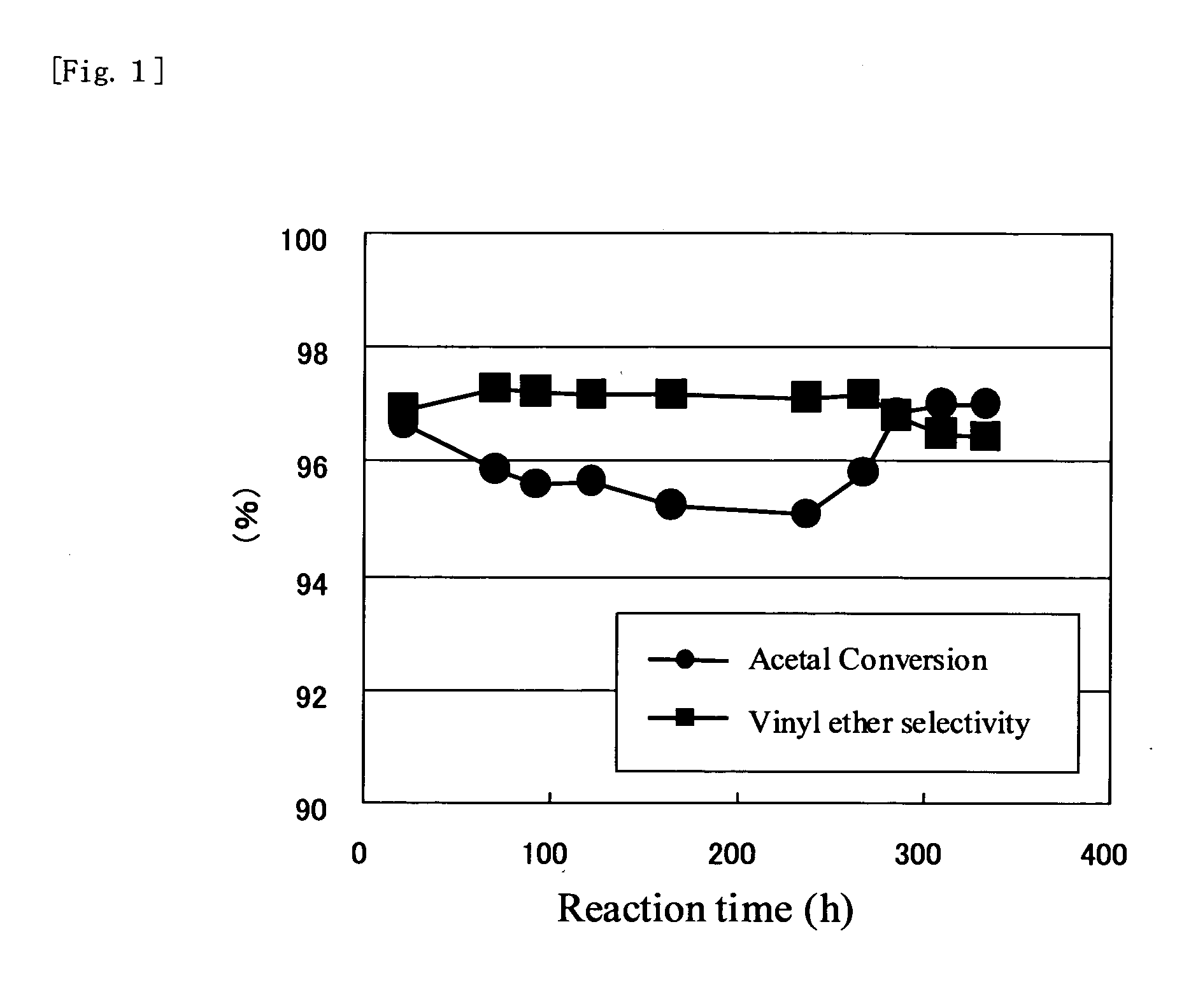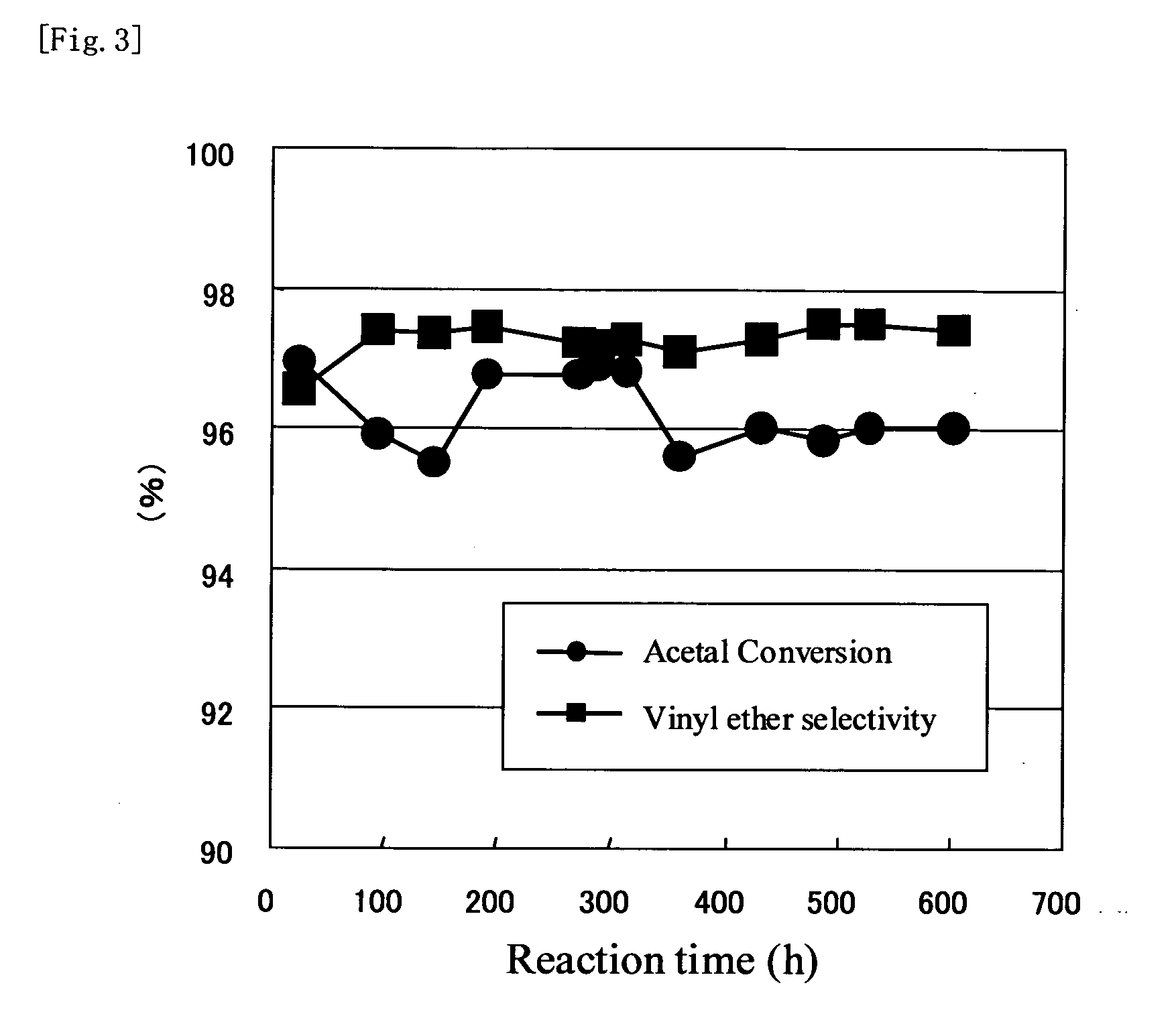Process for producing alpha, beta-unsaturated ether
a technology of alpha-beta-unsaturated ether and process, which is applied in the field of process for producing , unsaturated ether, can solve the problems of insufficient regeneration of catalysts or conventional catalysts, insufficient life of documents, and insufficient recycling of catalysts, so as to improve the productivity of -unsaturated ether and reduce the exchange frequency of catalysts
- Summary
- Abstract
- Description
- Claims
- Application Information
AI Technical Summary
Benefits of technology
Problems solved by technology
Method used
Image
Examples
example 1
Preparation of Catalyst
[0052]10 g of hydroxyapatite Ca5(PO4)3(OH) (manufactured by Wako Pure Chemical Industries, Ltd.) was pressure molded at 20 MPa for 5 minutes, and the particles formed were sieved to sizes from 0.85 to 1.70 mm in diameter. The particles were then placed in a calcination tube and were calcined at 350° C. under atmospheric pressure in a nitrogen atmosphere for 3 hours. The particles were cooled to room temperature in 1 hour while nitrogen was continuously flowed. A catalyst was thus obtained.
Preparation of Material:
[0053]500 ml of acetaldehyde diethyl acetal was given 170 g of molecular sieve 4A ( 1 / 16 inch diameter cylinder) and was allowed to stand still for 12 hours. The resultant dehydrated acetaldehyde diethyl acetal weighing 90 g was separated from the molecular sieve by decantation, and 0.063 g of acetic acid was added thereto. The water concentration and acetic acid concentration in the acetaldehyde diethyl acetal solution were determined to be 40 ppm and...
example 2
Preparation of Material
[0056]A material was prepared in the same manner as in Example 1 except that acetic acid was added in an amount of 0.253 g. The water concentration and acetic acid concentration in the acetaldehyde diethyl acetal solution were determined to be 40 ppm and 2808 ppm by weight, respectively, relative to the acetal.
Reaction Experiment:
[0057]Reaction was performed in the same manner as in Example 1. After 6 hours from the reaction initiation, the reaction solution obtained was analyzed by gas chromatography, confirming ethyl vinyl ether as a main product. The acetal conversion was 92.0% and the vinyl ether selectivity was 99.0%. The results are shown in Table 1.
example 3
Preparation of Material
[0060]A material was prepared in the same manner as in Example 1 except that 0.324 g of water was added instead of acetic acid. The water concentration and acetic acid concentration in the acetaldehyde diethyl acetal solution were determined to be 3613 ppm by weight and below the detection limit (below 2 ppm by weight), respectively, relative to the acetal.
Reaction Experiment:
[0061]Reaction was performed in the same manner as in Example 1. After 6 hours from the reaction initiation, the reaction solution obtained was analyzed by gas chromatography, confirming ethyl vinyl ether as a main product. The acetal conversion was 78.9% and the vinyl ether selectivity was 95.5%. The results are shown in Table 1.
PUM
| Property | Measurement | Unit |
|---|---|---|
| concentration | aaaaa | aaaaa |
| β | aaaaa | aaaaa |
| catalytic performance | aaaaa | aaaaa |
Abstract
Description
Claims
Application Information
 Login to View More
Login to View More - R&D
- Intellectual Property
- Life Sciences
- Materials
- Tech Scout
- Unparalleled Data Quality
- Higher Quality Content
- 60% Fewer Hallucinations
Browse by: Latest US Patents, China's latest patents, Technical Efficacy Thesaurus, Application Domain, Technology Topic, Popular Technical Reports.
© 2025 PatSnap. All rights reserved.Legal|Privacy policy|Modern Slavery Act Transparency Statement|Sitemap|About US| Contact US: help@patsnap.com



